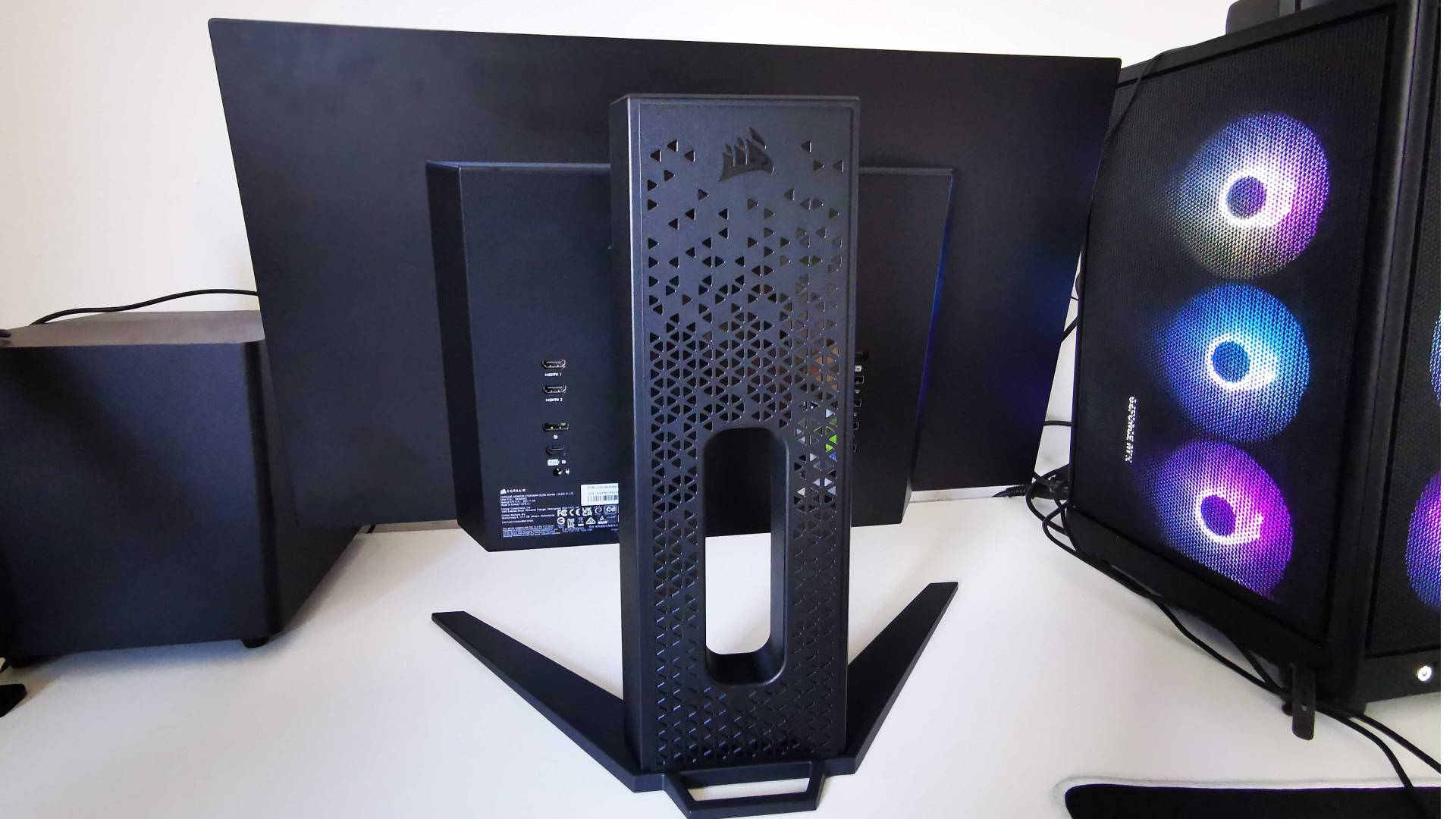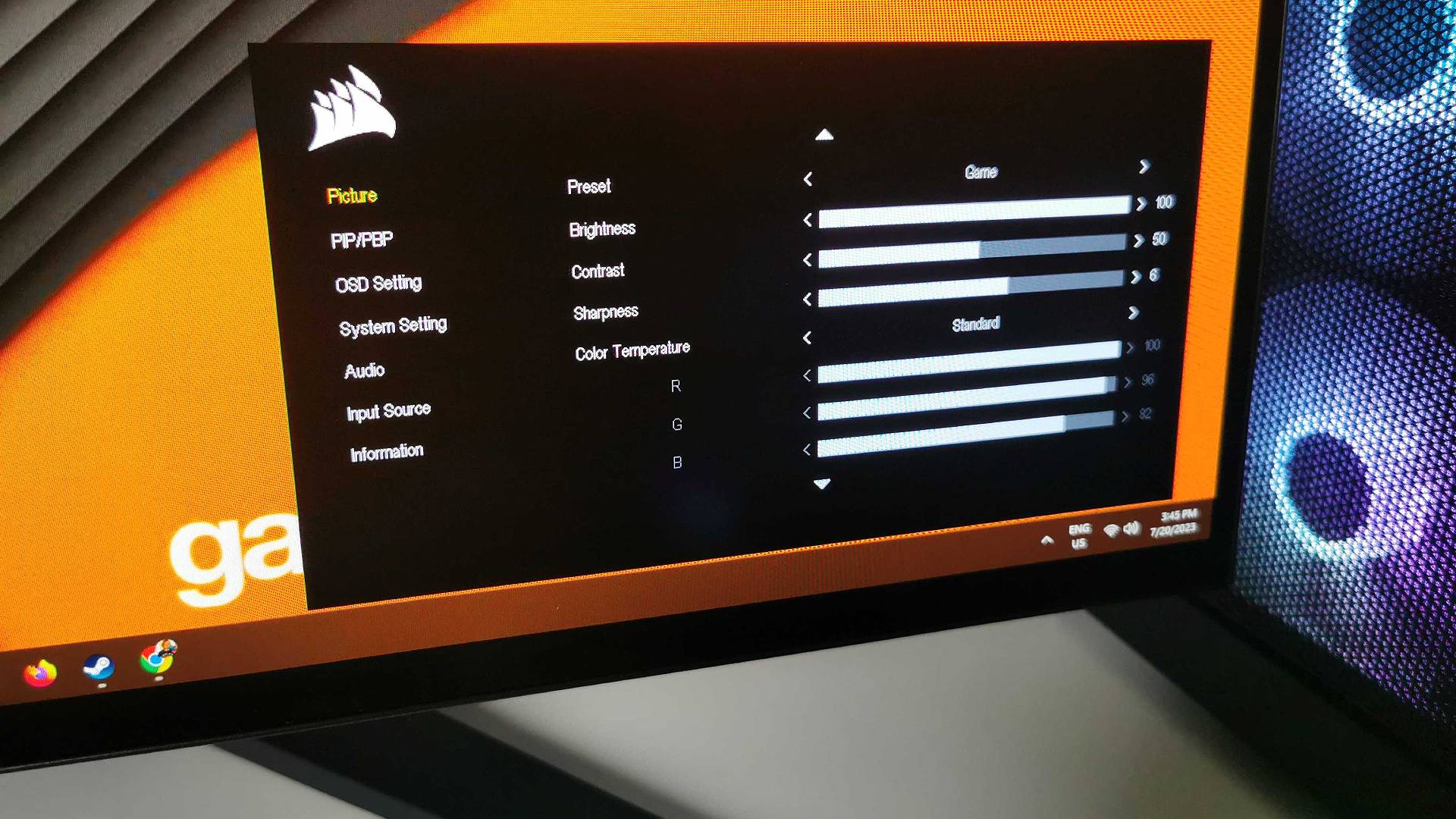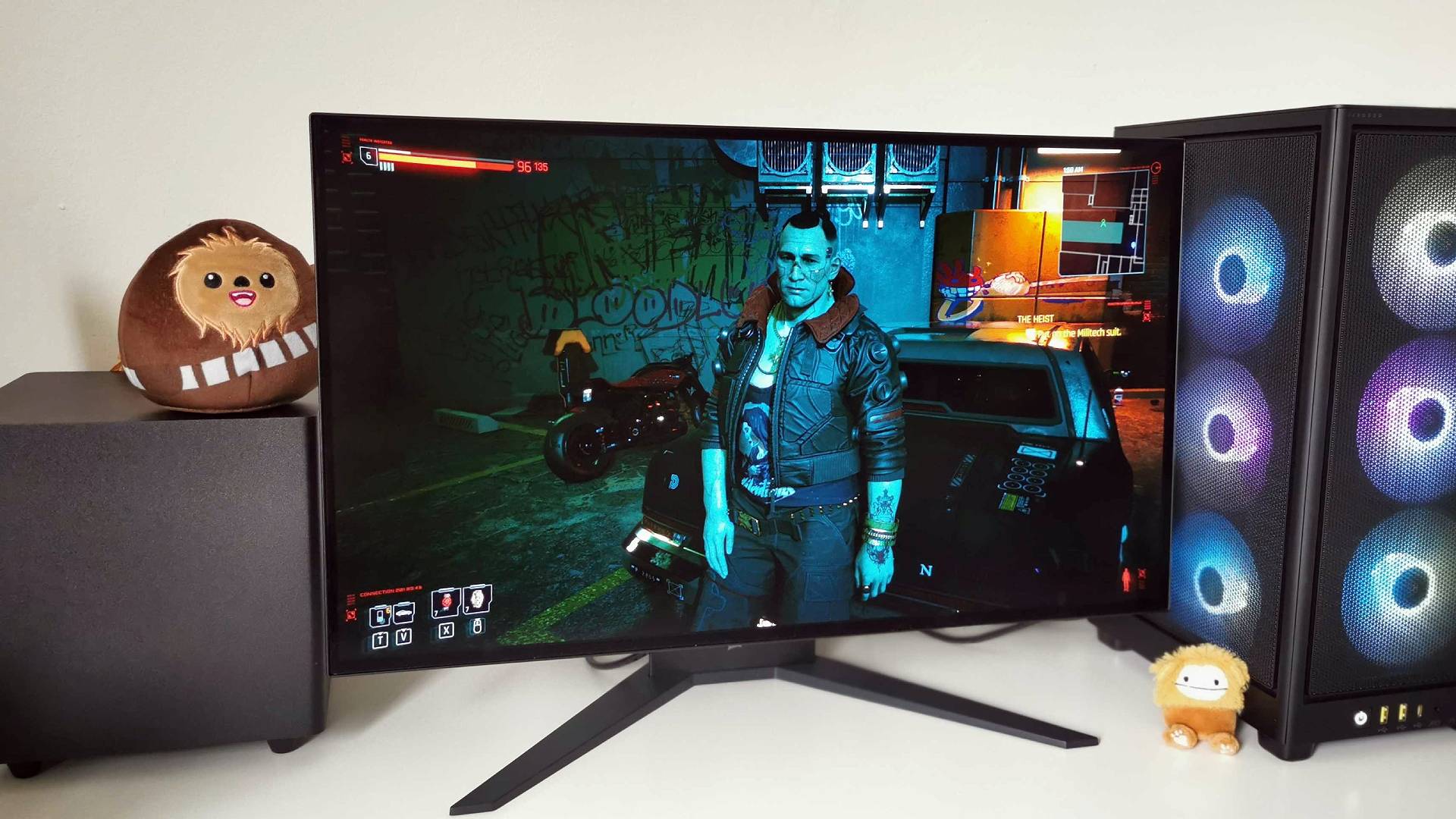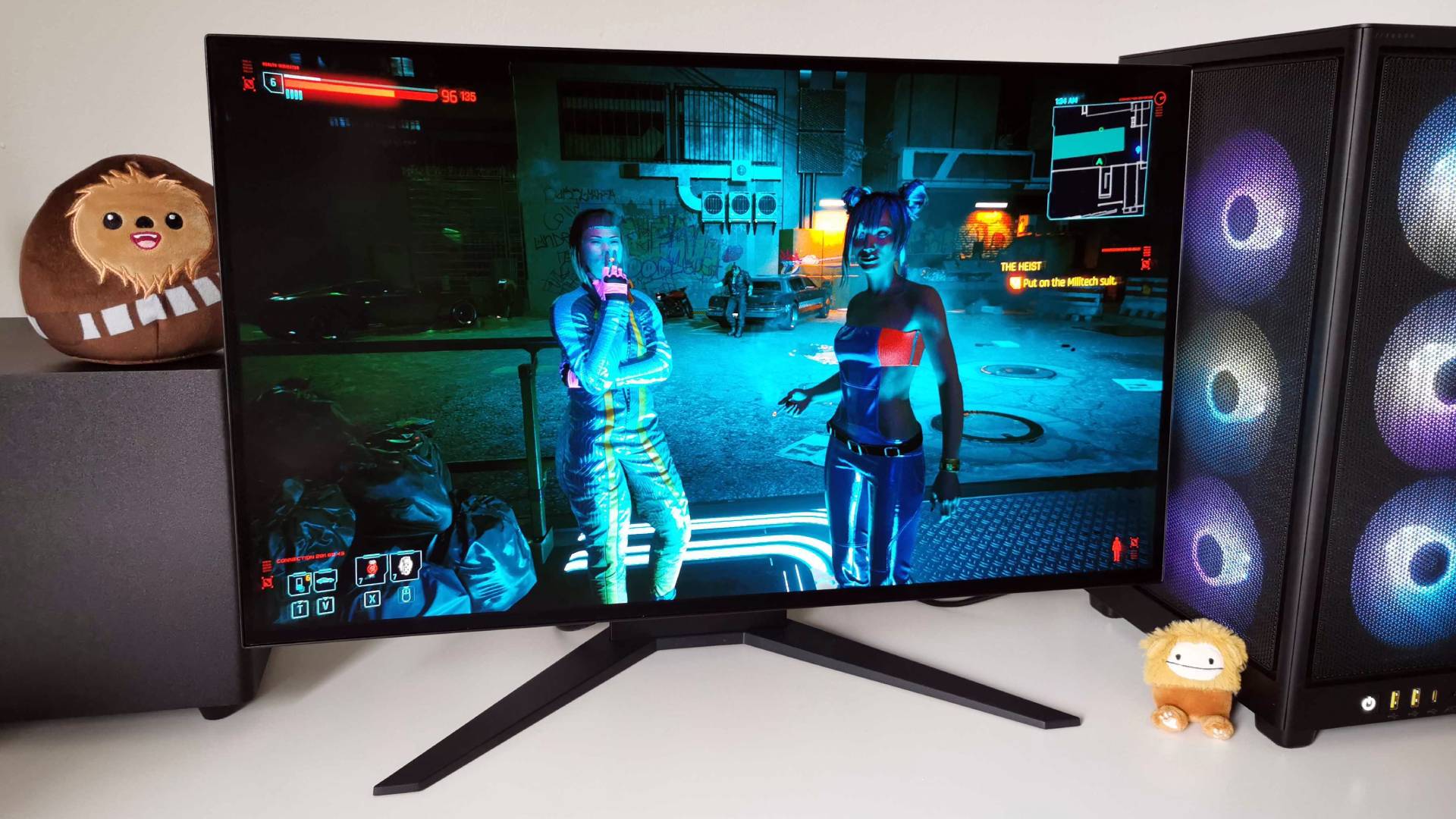GamesRadar+ Verdict
More often than not, premium gaming monitors target 4K PC gaming, but the Corsair Xeneon 27QHD240 makes a case for choosing a speedy QHD OLED panel instead. This display is a testament to the idea that screen type is more important than resolution, and the visual difference between this 1440p display and cheaper UHD screens is remarkable. If you’re looking for something that’ll trick your eyes into believing they’re gazing at your favorite digital worlds, Corsair’s color-rich display has you covered, and 240Hz abilities give it a competitive kick.
Pros
- +
Excellent OLED panel
- +
Speedy 240Hz refresh rate
- +
Tons of ports
Cons
- -
Extravagant price
- -
OSD buttons are subpar
Why you can trust GamesRadar+
The Corsair Xeneon 27QHD240 might be expensive for a 1440p display in 2023, but I’m here to tell you that you should consider it over 4K alternatives? Why? Well, its LG OLED panel and speedy 240Hz refresh rate are somewhat of a perfect match, particularly if you’re looking for smooth visuals that pop. Not to mention Corsair has packed LG’s screen tech into a striking yet subtle 27-inch monitor setup, even if I’ve got beef with the OSD buttons.
Priced at $999, the Corsair Xeneon 27QHD240 is firmly a member of the premium panel party, and its MSRP is a kicker. I actually had to have words with myself going into this review, as I was determined not to let the price point put a complete damper on things. Thankfully, the OLED panel puts on a show that takes the edge off the cost, one that provides it with a place at the best gaming monitor table.
Yes, it’s small, costs a grand, and isn’t UHD, but the Corsair Xeneon 27QHD240 trades 4K for speedy OLED gaming monitor brilliance. While 240Hz is going to matter more to FPS game fans looking for a performance edge, I reckon I’d choose hertz over resolution now that I’ve tried this screen for myself, especially when paired with organic LED loveliness.

Specs
I’ve already spilled the beans on Corsair Xeneon 27QHD240 specs, but let’s officially go over what the monitor features. At the core of this display is the aforementioned 26.5-inch LG QHD 240Hz panel, armed with an anti-glare coating and features like NVIDIA G-Sync Compatibility. It also boasts a charcuterie board of ports, including two HDMI 2.1, one DisplayPort 1.4, and a Type-C connector with DisplayPort Alt-Mode.
| Price | $999 / £1,049.99 |
| Screen size | 26.5-inches |
| Screen type | OLED |
| Resolution | 2560 x 1440 |
| Brightness | 150nit (100% APL) / 450nit (Peak, 25% APL) / 800nit (10% APL HDR) / 1000nit (3% APL HDR) |
| Response time | 0.03ms GtG |
| Viewing angle | 178° / 178° |
| Contrast ratio | 1,500,000:1 |
| Color support | 100% Adobe RGB, 98.5% DCI-P3 |
| Inputs | 2x HDMI 2.1, 1x Display Port 1.4, 4x USB-A, 2x USB-C, 3.5mm auxiliary audio output |
| Weight | 13.9lbs (6.3Kg) |
If you’re considering a 240Hz monitor, you’re likely thinking of pairing it with a gaming PC, but both HDMI 2.1 support and 4K input support should attract console players. Not that I’d suggest dropping this sort of money on a PS5 monitor, especially since 120Hz is the current output limit.
Design and features
The monitor’s stand pivots, swings, and is height adjustable, and moving the screen is easily achieved with one hand. I can’t imagine many people out there will pick this screen up as a vertical spreadsheet portal, but if you’re into retro games like me, it’s an opportunity to hook up an old Nintendo Gamecube and play the arcade shooter Ikaruga in portrait tate mode.
The screen itself is ultra thin, with most of the bulk being contained to a lump on the back. Just like many other monitors out there now, the Xeneon 27QHD240 also barely has a bezel, with a black border being the only thing preventing the panel from being truly edge-to-edge. However, that fact doesn’t distract from its slick aesthetic, and it backs up the idea that less is more when it comes to desktop panel designs.

If you’ve heard OLED screen burn horror stories, you’ll be pleased to know that Corsair has that covered. In the OSD setting menu, you’ll find an ‘Image Retention Refresh’ option, which should shift any temporary ghosting should it occur. Whether or not proper screen burn will become an issue with long term use remains to be seen, but a reminder will pop up after eight hours telling you to use the feature, and it’s probably worth sticking to to avoid static images haunting your experience.
This is the part where I start grumbling about the Xeneon 27QHD240’s OSD buttons, but I want to add some context before I moan a little. For starters, I hate discrete buttons at the best of times, and I’m a bit of an advocate for monitor’s coming with remotes. I’m perhaps already a little spoiled, as the Ben Q Mobiuz screen I normally use comes with a wireless clicker (flipper, doofer, whatever you want to call it) and is a blessing when it comes to navigating menus.
Rather than borrowing gaming TV features, the Xeneon 27QHD240 opts for a joystick approach, accompanied by two extremely flat buttons. The two left toggles are exclusively for power and input, and a handy sensor will show you which is which when you put your hand under. That’s fine and well, but using the nub to actually enter the main OSD menu and navigate around is a pain, and I ended up accidentally pressing directions when trying to click the centre. Again, maybe I’m spoiled, but it’s amazing how much time wrestling with controls can add to changing simple settings like brightness.

Performance
As you’d maybe expect with a monitor that costs a grand, the Xeneon 27QHD240 puts on quite the performance, but this display’s OLED abilities are a sight to behold. Admittedly, I’ve been using an IPS display for a while now, so the screen type switch switch up is perhaps impressing my eyes more than it would a seasoned OLED user. Nevertheless, I think this panel packs a hell of a visual punch, and games I regularly visit look fresher than ever.
I review all the latest graphics cards, so I find myself taking a fleeting trip to Night City to run some Cyberpunk 2077 benchmarks fairly often. The nature of my visit means I’m not much of a tourist about it, but I couldn’t help but wander through CD Projekt Red’s neon soaked streets while using the Xeneon 27QHD240. The excellent contrast and brightness that the OLED provides almost transforms the screen into a rectangular portal, with glowing lights and shimmering reflections that look like they’re actually within sight.
I might receive some flack for this, but I’m not always a fan of the experience HDR monitors provide. I understand the appeal, but I often find that colors sometimes look a little muted, and actually prefer the emulated HDR feature included with my usual BenQ Mobiuz display. Thankfully, the Xeneon 27QHD240 has managed to convince me that enabling the tech in games is worth it, and HDR10 support pairs perfectly with this OLED panel.

Don’t get me wrong, the Xeneon 27QHD240 doesn’t need HDR to look great, and it makes colors pop without the feature. However, with it switched on in the likes of Cyberpunk 2077, the streets receive a realistic glow up. Each dingy alleyway and illuminated sidewalk look almost like my home city of Glasgow, with the visuals registering in my brain as something I’d witness with my own eyes. I do think the colors end look looking slightly less saturated as a result, and I am a fan of the way neon lights look without HDR, but I think it’s a tradeoff I’m happy with.
I also immediately noticed the difference between my usual screen and the Xeneon’s 240Hz refresh rate. This actually caught me off guard, as I figured there wasn’t that much of a difference between 144Hz and 240Hz, and now I feel a little silly. That said, we’re also talking about a panel with a 0.03ms GtG response time, an added benefit of making the jump to OLED.

To properly put the monitor’s loft refresh rate to the test, I left the warm glow of Night City and jumped into the chaos of Overwatch 2. Conveniently, I just finished up our Origin Chronos V3 review, so I was able to hit 240fps at 1440p in the hero shooter without compromising on visuals using the rig. The result? Well, the game looked fantastic and darting around the sky as Farah felt super responsive, more so than while playing at 144Hz.
Before we move onto my final thoughts, I want to pay tribute to this monitor’s anti-reflective coating. My desk is positioned near a particularly glairy window, and while sunny days are a rarity in Scotland, I often need to reach for my blinds when things are on the brighter side. With the Xeneon 27QHD240, I actually forgot this was an issue entirely, and the screen does a fantastic job of keeping distracting reflections at bay.
Should you buy the Corsair Xeneon 27QHD240?
Its price is a sore spot, but if you’re looking for a screen that’ll wow your eyes with vivid colors and snappy movement, the Xeneon 27QHD240 will deliver. If you’re rocking an RTX 4080 graphics card, picking up a 1440p display in 2023 might feel like an odd decision, but as someone who uses a 4K 144Hz panel, OLED and 240Hz will distract you from the caveats of lower resolutions. Not to mention you’ll be able to enjoy ridiculously high frame rates if you’re rocking one of the best graphics cards, rather than trying to boost fps to suit the demands of UHD.
It’s not exactly a con, but if you’re used to using a larger display, you might feel like the 27-inch Corsair Xeneon is on the small size. I miss the size of my 34-inch daily driver less when engrossed with gameplay, but when it comes to carrying out every day work tasks, I do feel like things are a little cramped. So, if you’re not into dinky displays, you might want to look for something bigger with similar specs, but I suspect Corsair’s chosen dimensions are part of the screen’s winning formula.
How we tested the Corsair Xeneon 27QHD240
I replaced my usual monitor with the Corsair Xeneon 27QHD240, using it for a month for work and gaming. During my time with the screen, I used the display to test an RTX 4080 gaming PC build, which in turn involved benchmarking Cyberpunk 2077 and a selection of other test games.
Outside of controlled testing, I used the Xeneon 27QHD240 to play some Overwatch 2, and I also used a Steam Deck Dock to play some lighter games using Valve’s handheld PC. If you’d like to know more about how we handle all of our review, swing by our Hardware Policy for more details.
Looking for more premium panels? Check out our Best high refresh rate monitor picks for a range of speedy screens. Alternatively, take a look at the best 4K gaming monitors for high spec UHD displays.

Phil is the Hardware Editor at GamesRadar and joined the team in 2023. In the past, they've also contributed to the likes of TechRadar, The Daily Star, the BBC, and PCGamesN, but these days, they specialize in testing the latest gaming handhelds, monitors, TVs, and PC components. They're also extremely nerdy about retro consoles and playing the classics on both new and old systems.



